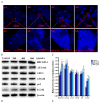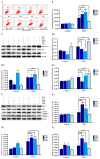BECLIN-1-Mediated Autophagy Suppresses Silica Nanoparticle-Induced Testicular Toxicity via the Inhibition of Caspase 8-Mediated Cell Apoptosis in Leydig Cells
- PMID: 35740992
- PMCID: PMC9221084
- DOI: 10.3390/cells11121863
BECLIN-1-Mediated Autophagy Suppresses Silica Nanoparticle-Induced Testicular Toxicity via the Inhibition of Caspase 8-Mediated Cell Apoptosis in Leydig Cells
Abstract
Accumulation of silica nanoparticles (SNPs) in the testes leads to male reproductive toxicity. However, little is known about the effect and mechanistic insights of SNP-induced autophagy on apoptosis in Leydig cells. In this study, we aimed to verify the role of SNP-induced autophagy in apoptosis and explore the possible underlying mechanism in mouse primary Leydig cells (PLCs). H&E staining showed that SNPs changed the histological structures of the testes, including a reduction in the Leydig cell populations in vivo. CCK-8 assay showed that SNPs decreased cell viability, and flow cytometry showed that SNPs increased cell apoptosis, both in a dose-dependent manner in vitro. Additionally, Western blotting further found that SNPs activated autophagy by an increase in BECLIN-1, ATG16L, and LC3-II levels and promoted the intrinsic pathway of apoptosis by an increase in the BAX/BCL-2 ratio, cleaved the caspase 8 and caspase 3 levels. Furthermore, autophagy decreased SNP-induced apoptosis via regulation of the caspase 8 level combined with rapamycin, 3-methyladenine, and chloroquine. BECLIN-1 depletion increased the caspase 8 level, leading to an increase in SNP-induced cell apoptosis. Collectively, this evidence demonstrates that SNPs activated BECLIN-1-mediated autophagy, which prevented SNP-induced testicular toxicity via the inhibition of caspase 8-mediated cell apoptosis in Leydig cells.
Keywords: BECLIN-1; Leydig cells; apoptosis; autophagy; silica nanoparticles; testicular toxicity.
Conflict of interest statement
The authors declare no conflict of interest.
Figures









Similar articles
-
Activation of Autophagy by Low-Dose Silica Nanoparticles Enhances Testosterone Secretion in Leydig Cells.Int J Mol Sci. 2022 Mar 13;23(6):3104. doi: 10.3390/ijms23063104. Int J Mol Sci. 2022. PMID: 35328525 Free PMC article.
-
Zearalenone induces apoptosis and cytoprotective autophagy in primary Leydig cells.Toxicol Lett. 2014 Apr 21;226(2):182-91. doi: 10.1016/j.toxlet.2014.02.003. Epub 2014 Feb 11. Toxicol Lett. 2014. PMID: 24530352
-
Role of autophagy in di-2-ethylhexyl phthalate (DEHP)-induced apoptosis in mouse Leydig cells.Environ Pollut. 2018 Dec;243(Pt A):563-572. doi: 10.1016/j.envpol.2018.08.089. Epub 2018 Sep 5. Environ Pollut. 2018. PMID: 30216888
-
Role of Autophagy in Zinc Oxide Nanoparticles-Induced Apoptosis of Mouse LEYDIG Cells.Int J Mol Sci. 2019 Aug 19;20(16):4042. doi: 10.3390/ijms20164042. Int J Mol Sci. 2019. PMID: 31430870 Free PMC article.
-
Delayed effects of autophagy on T-2 toxin-induced apoptosis in mouse primary Leydig cells.Toxicol Ind Health. 2019 Mar;35(3):256-263. doi: 10.1177/0748233719831122. Toxicol Ind Health. 2019. PMID: 30862294
Cited by
-
The Role of Environmental Endocrine Disruptors on Leydig Cell Death and Senescen.World J Mens Health. 2025 Jul;43(3):477-491. doi: 10.5534/wjmh.240254. Epub 2025 Jan 16. World J Mens Health. 2025. PMID: 39843178 Free PMC article. Review.
-
Taurine Protects against Silica Nanoparticle-Induced Apoptosis and Inflammatory Response via Inhibition of Oxidative Stress in Porcine Ovarian Granulosa Cells.Animals (Basel). 2024 Oct 14;14(20):2959. doi: 10.3390/ani14202959. Animals (Basel). 2024. PMID: 39457890 Free PMC article.
-
Silica Nanoparticles Promote Apoptosis in Ovarian Granulosa Cells via Autophagy Dysfunction.Int J Mol Sci. 2023 Mar 8;24(6):5189. doi: 10.3390/ijms24065189. Int J Mol Sci. 2023. PMID: 36982262 Free PMC article.
References
MeSH terms
Substances
Grants and funding
LinkOut - more resources
Full Text Sources
Research Materials

